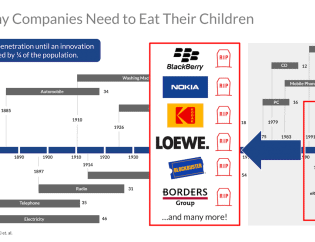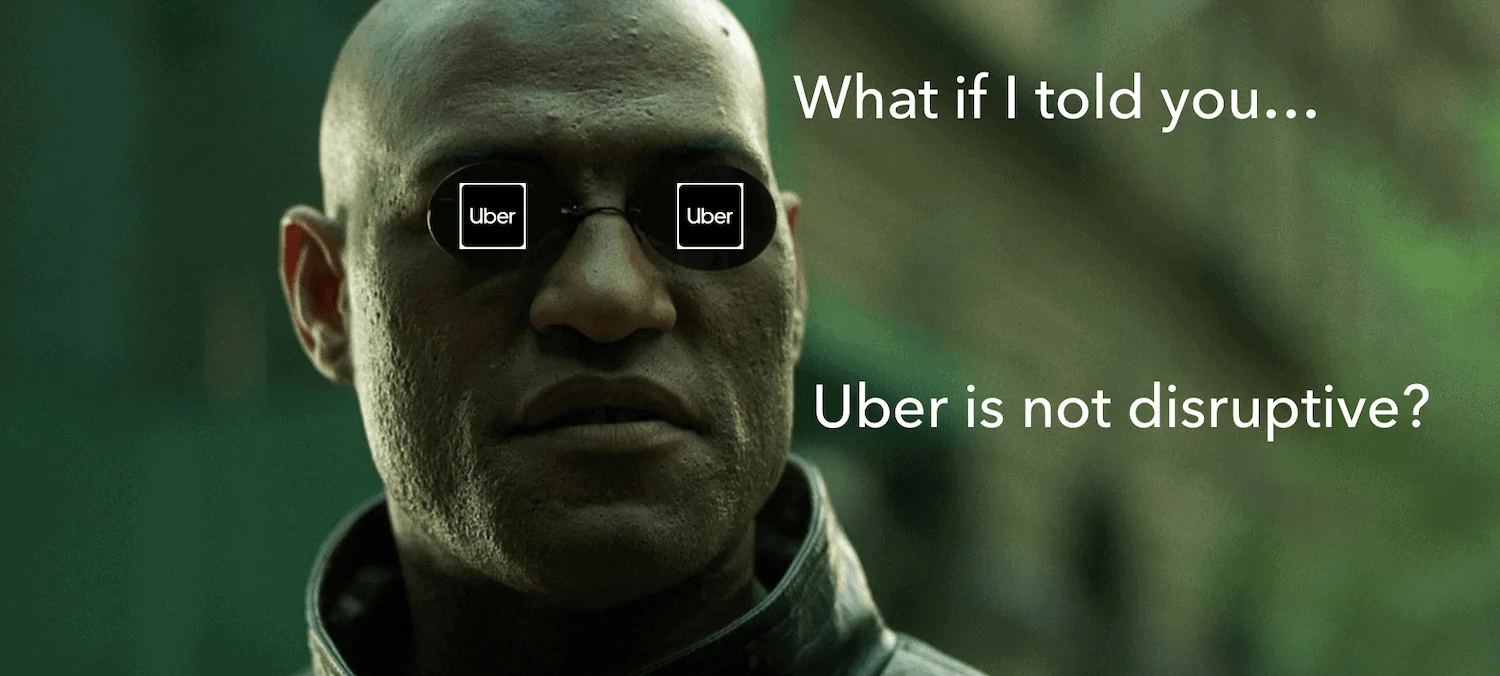
0. What You’ll Learn
In my last article here (German) I explained that today's main challenge (many call it “digital transformation”) facing almost all companies is not digital, but an organizational one. It also has nothing to do with digital business models, like many want to believe.
This article will cover a slightly different topic - a widespread misconception about Uber and “disruption” in general. I will therefore explain:
- Why almost everyone around you is misusing the term “disruption” and has been misapplying it for years.
- The different innovation types, along with some prominent examples for each of them.
- What actual disruption looks like and how it takes place, by citing an example from the steel industry and showing you how integrated steel mills, dominating the steel industry for decades, were blindsided and overrun by an initially inconspicuous technology.
- How you determine if an idea or startup has any disruptive potential at all.
- Why Uber is not a disrupting the cab industry, despite what the majority believes.
- What you should focus on instead, so that your idea or company will increase its chances to become a disruptor itself.
1. Defining “Disruptive Innovation” and Why Almost Everyone around You Is Misusing the Term
Before I can explain in detail why Uber is not disruptive, we need to first have a clear understanding what disruption actually means. If you think you already know, then let me ask you the following question:
- Would you consider the first automobile to be a disruptive technology?1
If your answer is “no”, then you can skip this part (if you so choose), as it seems you already have a good understanding of the definition that the godfather of innovation Clayton M. Christensen came up with. If your answer is “yes”, then the following should prove to be very insightful. And you’ll have a much better grasp of what the concept of disruption really means than 90% of the people that use the term in daily business.
The term was first coined and defined by Clayton M. Christensen, famous for his seminal book “The Innovator's Dilemma” published in 1997. Today his concept of “disruptive innovation” is present in our everyday language about innovation.
Ironically, disruption theory is becoming a victim of its own success. Despite its broad usage, the core concepts have been widely misunderstood and its basic principles have been misapplied.2 I’m always shocked by how loosely the term is tossed around or how people roll their eyes at the mere mention of “disruption”. This is in part due to sloppy references from writers and journalists. And to make matters worse, it seems they haven’t read a serious book or article on the subject. Oftentimes, startups and even consultants use the term vaguely to invoke the concept in support of whatever it is they wish to sell or convey, even though their product or service just simplifies an existing technology, not displaces it.
”You're not that disruptive. Stop lying to yourself!”
— Rameet Chawla
By misunderstanding this one critical term, we lose much of the understanding and power of the innovator’s dilemma. This is similar to German companies using the term “Digital Transformation”. Everybody uses it, almost nobody can give you an accurate definition. And even if they did, they would come to understand that “Digital Transformation” does not solve the problems of today's companies in a VUCA world.
Furthermore, if we use “disruptive innovation” to describe any situation in which an industry is shaken up and where incumbents fall, this usage would be much too broad. Applying the concept correctly matters and is critical in order to realize its benefits. A small competitor that steals small parts of your market share can likely be ignored, unless they’re on a disruptive path, in which case it could be a very fatal threat to your company. However, both of these challenges need to be addressed fundamentally different!
The concept of disruptive innovation is used to describe technology that uproots, and eventually replaces, an existing technology (e.g. video streaming eventually replacing video rentals).
Making the Distinction between Sustaining, Breakthrough and Disruptive Innovation
In order to correctly identify which innovation types we’re dealing with, we need to talk about the three types of innovation. These will also be the definitions I will use throughout this article to stay consistent, as to not lose the power of the concept.
Sustaining (or incremental) innovation is continuous technological improvement to an existing product, service or process within the context of your existing business model.The goal is to do what you already do better e.g. three-bladed razor becoming a five-bladed one. Generally, the lion's share of innovation that happens in companies fall into this category.
A breakthrough (or radical) innovation is a change to an existing product, service or process that has a significant impact on the business, but still fits within the company’s business model. Think of the Motorola Razr. Even though it was a clamshell, it pushed the boundaries of design and was a runaway success for Motorola. This sometimes allows companies to leapfrog ahead of its competition, but the innovation stays within the core offerings.
Finally, disruptive innovation is a new product, service or process that either creates a new market or enters at the bottom/low-end of the market and is initially considered inferior to the existing offering as it moves up and displaces established incumbents e.g. streaming services such as Spotify or Netflix displacing the CompactDisc.
”The electric light did not come from the
continuous improvement of candles.”
— Oren Harari
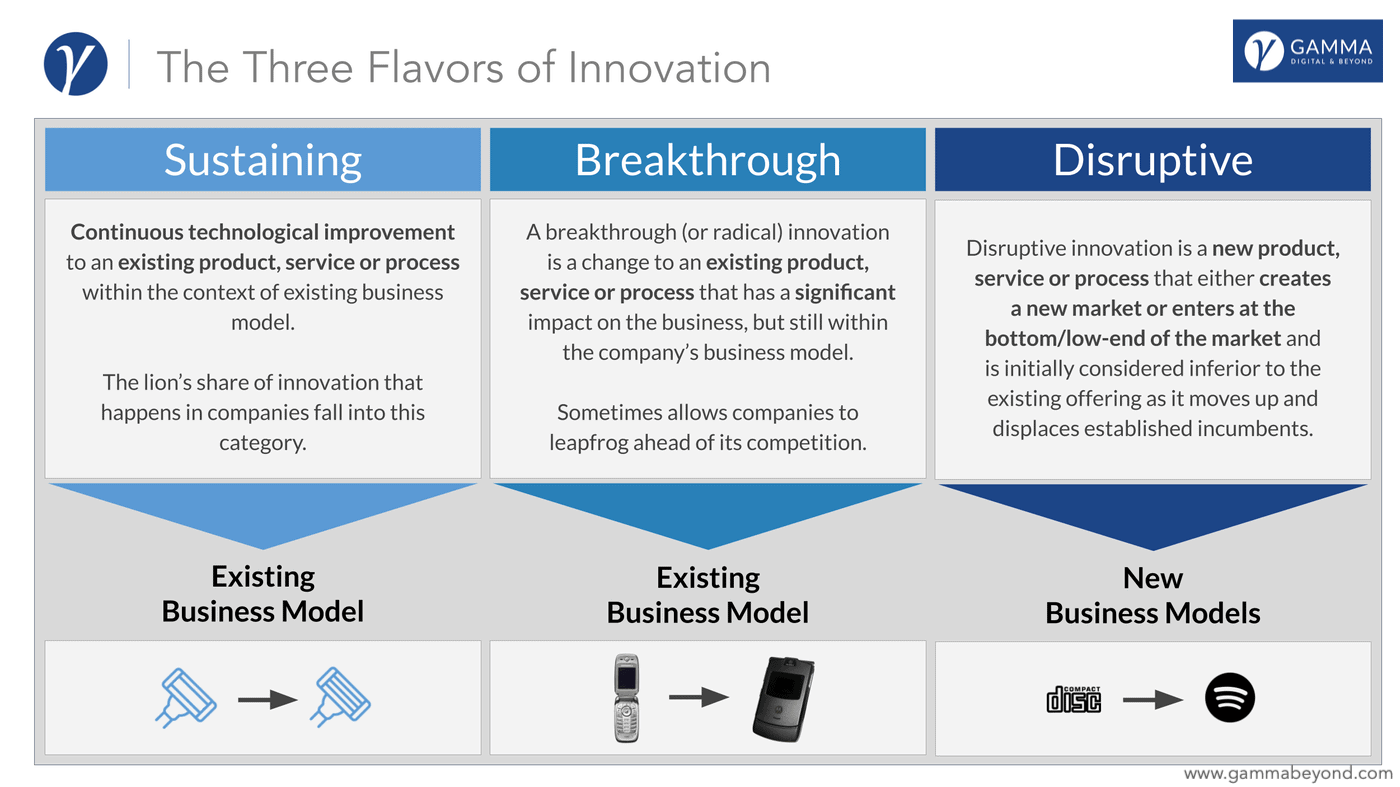
The main reason “disruptive” causes so much confusion is that it sounds like a “major upset”, which seems to suggest that the technological cause should be major as well. This in turn, leads many to falsely believe that disruptive innovation coincides with technically radical innovation. So people end up confusing disruptive with radical innovation. The opposite of disruptive is sustaining.
A disruptive innovation may or may not represent a radical innovation. Also, a radical breakthrough may or may not be disruptive, while an incremental innovation can be extremely disruptive. In fact, most documented cases of disruption originated from an incremental change that was well within the technical capabilities of the incumbent. On the flip side, companies have also taken huge risks and engineered extremely complex new innovations that were hugely successful with their existing mainstream customers, but are considered sustaining e.g. Boeing 787.
Key Takeaways
- The basic concept of disruption theory has been widely misunderstood and its principles misapplied, losing much of the power of the innovator’s dilemma.
- Innovation generally comes in three flavors: sustaining, breakthrough and disruptive.
- Disruption has little to do with technology per se.
- Disruption is a process. It doesn’t refer to a product or service at one fixed point, instead it’s an evolution of that product or service over time, which, in some cases can take decades.
- Disruption is relative to the industry. An innovation can be sustaining in one industry, but disruptive in another.
- Disruption originates from two types of markets - low-end or new-market. Low-end disruptors start with a “good enough” product at the low-end of the market. New-market disruptors create a market where none existed before.
- If we get sloppy with our definitions or fail to apply the concept correctly, we may end up using the wrong tools and strategies for a given context, reducing our chances of success or miscategorizing companies as disruptive.
2. The Rise of the Mini Mills
To better understand what actual disruption looks like and how it takes place, let’s look a prominent example from the steel industry - an industry I have had the pleasure working with extensively, as I’ve helped companies such as Kloeckner Metals define their strategy and develop ways to disrupt their own industry. We will do this by examining the developments in the steel industry from the years 1965-1990s
Enter the Integrated Steel Mills…
Historically, high-quality steel production was regarded as the domain of incumbents, the integrated steel plants, and were unrivalled in terms of quality and production capacity. Their large market share and high added value guaranteed success.
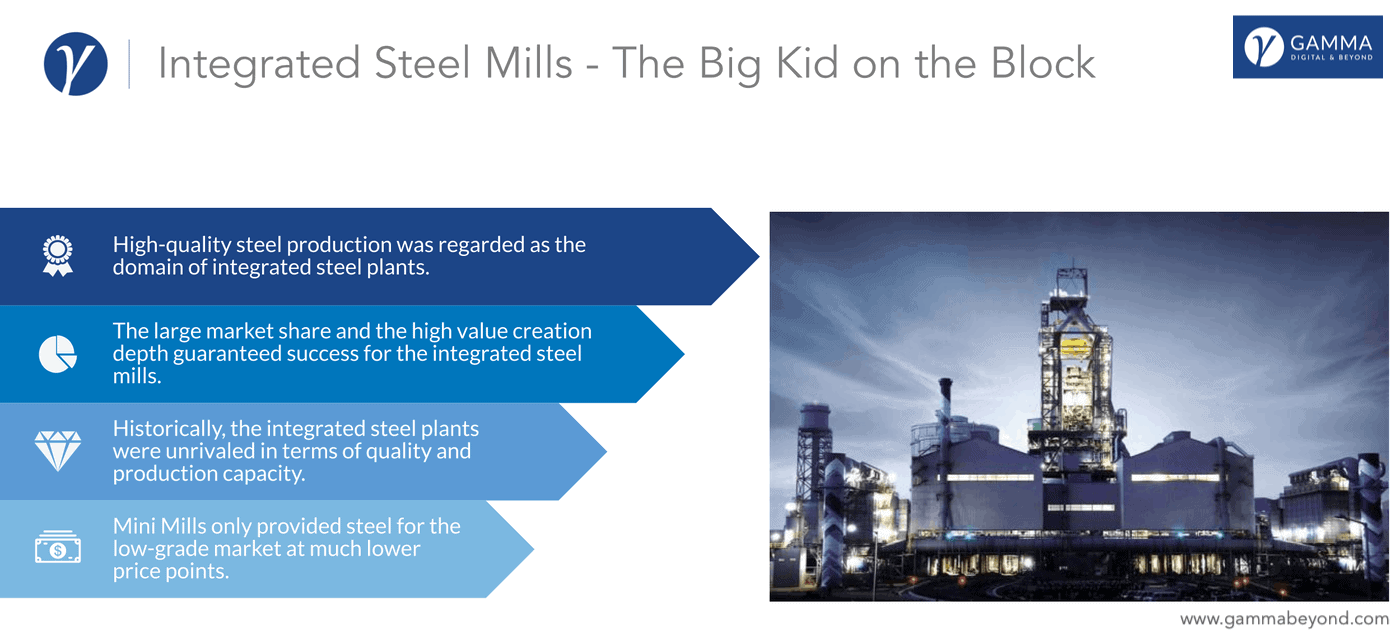
But in the mid-1960s mini mill steelmaking started to become commercially viable. Mini mills, pioneered by Nucor, employed widely available technology and equipment, using electric arc furnaces to melt scrap steel (as opposed to blast furnaces to melt iron) and then roll these into end products such as bars, rods, beams or sheets.3 And even though the integrated mills and mini mills look very similar, scale is the only differentiating factor. Mini mills use furnaces that are roughly 20 meters in diameter and 10 meters high, which is where they get their name from.
It costs approx. $8B USD to build a competitive integrated steel mill requiring the output to be much greater than that of mini mills. In contrast, mini mills can be built for much less and can produce steel at a fraction (less than 1/10th to be exact) of that of an integrated mills, making mini mill steelmaking a highly disruptive technology.
One would think that every integrated steel company would have adopted the low-cost mini mill technology, especially since steel is a commodity. Yet not a single integrated steel company had invested in a mini mills even after the technology occupied nearly half of North America’s steel production in 2000.
3. How Disruption Finds Its Next Lunch - A Quick Rundown
Disruptive innovation usually starts out with a low-quality product (i.e. rebar, also see chart below) in a low-volume and/or low-margin segment (i.e. construction) of a much larger and more mature market. The customers of this “lower” segment demand product attributes that mainstream customers (i.e. sheet metal) do not and are willing to give up performance. Or simply put, the disruptive innovation is not good enough for mainstream customers. More so, mainstream customers straight out reject the disruptive innovation, holding the incumbent hostage of its own success.
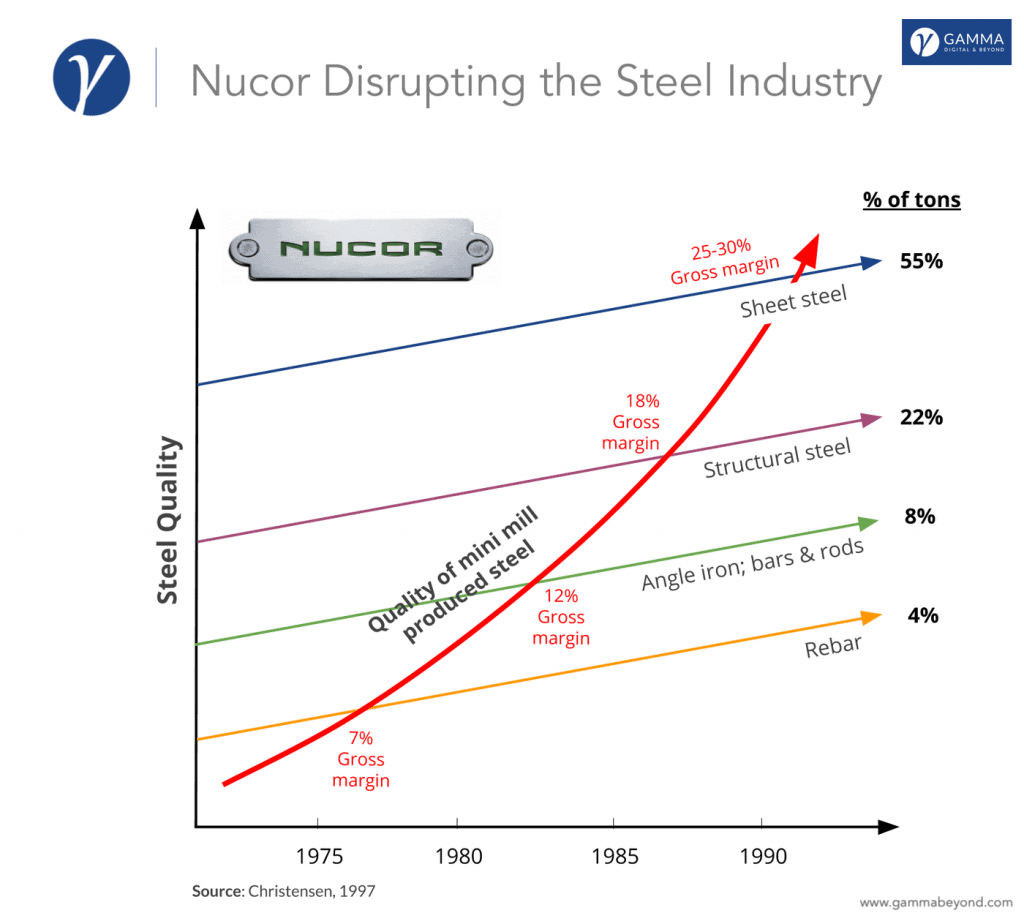
Because mini mill technology was inferior in the beginning, it could not provide all the higher quality steel products as could the integrated steel mills. In this stage new technologies4 can either be inefficient and seem more expensive, due to the fact that technologies have not yet scaled, or seem cheaper because they simply do less.5
The reaction from the incumbent also follows a predictable pattern (see chart below) - it is generally one of denial6. Furthermore, the incumbent is forced to ignore the new technology, as it is often a market segment of low interest (i.e. low-volume/low-margin) and does not meet the growth requirements dictated by its much larger company size. As such, the integrated steel mills exited the rebar market (remember it only accounted for 4% of the total market in tons) and left it for the mini mills to feast on.
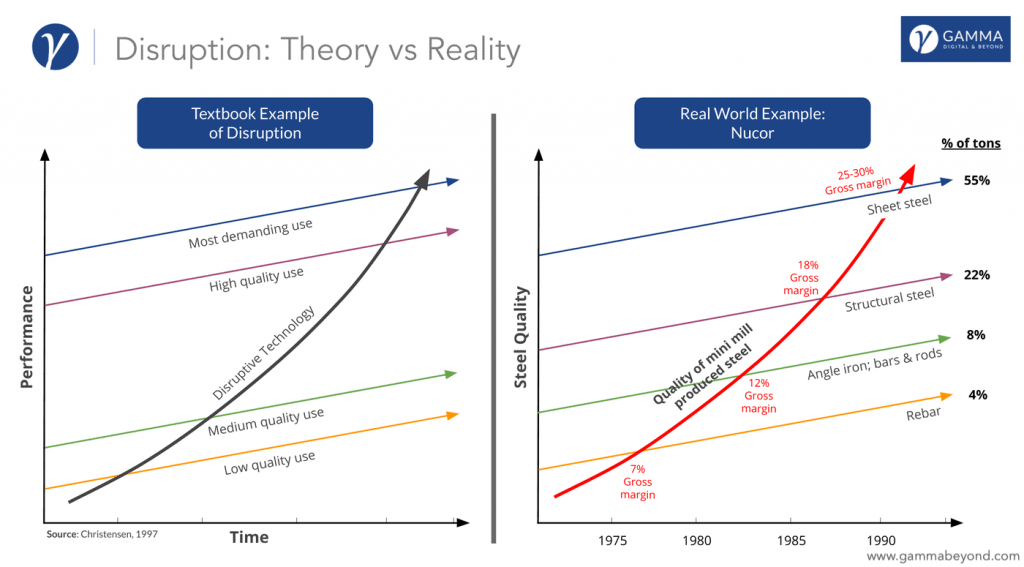
As time went on, the mini mills occupied the rebar segment and started growing rapidly, solving their initial quality problems while retaining their cost advantage. This is normally where the disruptor goes through a rapid learning curve, solving further quality/performance issues and suddenly starts threatening the incumbent in its main markets e.g. angle, bars and rods.
The integrated steel mills scrambled to put together a response. But almost always this fails, as so in this case, because of the disruptor’s head start and culture that is much more adaptable (read agile), and retreats to a higher-end market e.g. structural steel.
Ultimately, the market begins to demand the replacement of the incumbent technology with the new technology. At this point, the whole market begins to see the potential and capabilities of the new technology, forcing the incumbent further up-market (e.g. sheet steel) and into a dead end with no market left to go to.
It’s important to reiterate: Disruption has little to do with technology or digital business models per se. That's why companies shouldn't focus the digital part of the digital transformation “movement” as they tend to do in Germany. But unfortunately, this point is lost on most companies.
Key Takeaways
- Because companies do not fully embrace the powerful principles of the Innovator’s Dilemma, incumbents regularly get disrupted in a predictable fashion - simply for doing everything right.
- Ironically, the companies respond in a very rational manner.
- Customers essentially hold companies hostage for being successful, demanding further improvements to its products and services for which they are willing to pay higher prices.
- Mainstream customers tend to reject disruptive technology.
- As companies retreat into more lucrative markets, it leads incumbents into a dead end with no escape.
4. How To Determine If An Idea or Startup Has Disruptive Potential
Ask yourself these three questions, to determine whether your idea or a particular startup has any disruptive potential or when trying to change a sustaining innovation into a disruptive idea for greater growth potential.
1. Does it have low-end disruption potential?
- Can you identify customers at the low-end of the market, who would be willing to purchase a product7 with less (but good enough) performance or features if they could buy it for a cheaper price?
- Is there a business model where you can earn sufficient profits at lower prices in order to acquire business of over-served customers at the low-end?
2. Does it have new-market disruption potential?
- Are there potential customers (non-consumers) who have not had the money, equipment or skill to do a certain task themselves and have therefore gone without it altogether or have needed to hire someone with expertise to do it for them?
- Do customers need to visit a centralized location (physically or virtually) in order to use a product or service?
3. Does it disrupt at all?
- Is your idea disruptive to all relevant incumbents?
If your idea appears to be a sustaining innovation to one or more players, the chances will be stacked against you, and you then entrant, will be unlikely to win this battle.
More Examples of Actual Disruptive Technologies
Disruptive examples are almost endless - from hydraulic shovels disrupting cable-winch shovels (in the early 20th century), PCs disrupting mainframes computers, online streaming disrupting retail movie rentals, inkjet printers disrupting laser printers or the Nintendo Wii disrupting the Playstation and the Xbox. Just have a look at the examples listed below.
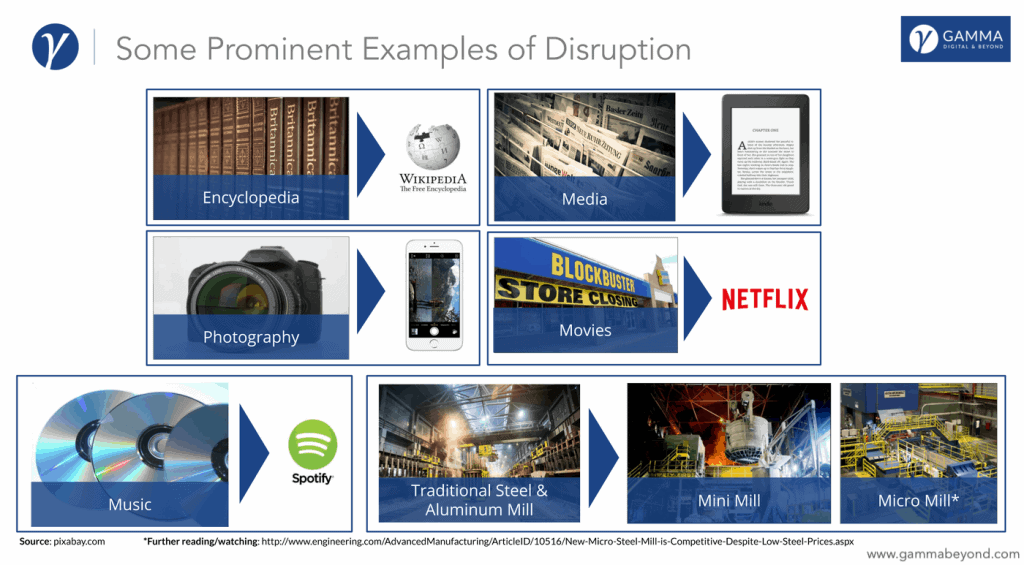
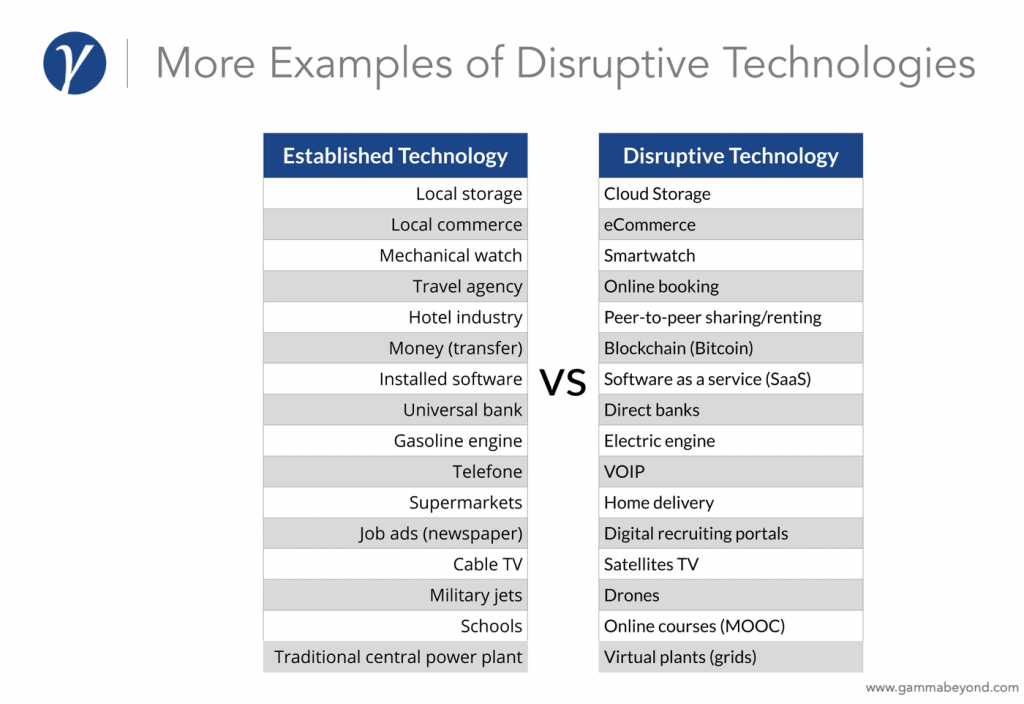
5. Why Uber is Not Disrupting the Cab Industry
Without a question, Uber is certainly transforming the taxi business, but is it really disrupting the industry?
The simple answer is “no”.
Just because a company or startup is highly successful, doesn’t automatically make it disruptive - despite how many people define it as such. Wanting something to be a certain way, does not make it so. Otherwise, the author of this article would already have his private island 🙂
But, if you’re still not convinced, let’s go through the previous questions (on how to determine if an idea or startup has disruptive potential) one by one, by answering them for Uber.
Questions 1 and 2 pertain to low-end and new-market disruption. As I’ve already outlined, disruption originates from two types of markets - low-end or new-market.
Low-end disruption can take place, because incumbents typically try to provide their most profitable and demanding customers with improvements to their products and services, paying less attention to less-demanding customers and thus moving up-market. The previous mini mill example is an excellent example for low-end disruption. The mini mills (disruptor) provided low-end customers with a “good enough” product (re-bar) and then, over time, slowly moved up-market.
In the case of new-market disruption, disrupters create markets where none existed before. Simply put, they turn non-consumers into consumers, by providing and simplifying technology that new customers can use. A good example of this was the personal computer that made it affordable and simple to make calculations that were previously reserved for mainframes.
Uber did not start off from either a low-end or a new-market. It would be very difficult for anyone to claim that Uber exploited a low-end opportunity in the market. If that were the case, then that would have meant cab providers were over-serving their customers by making cabs e.g. too accessible, too easy to use or providing too many cabs. If anything, I would argue that Uber rides are more convenient and more cleanly than your average cab.
Also, Uber did not serve customers that found existing alternatives too expensive or too inconvenient, so that they took public transport or drove themselves instead. Remember, Uber initially launched its service in San Francisco, a well-served market and they typically cost 50% or more than a cab (and that didn’t include “surge pricing”). Furthermore, Uber’s customers were primarily people who already hired rides.
UberSELECT (currently a small part of Ubers overall revenue) is an exception, because the limousine or “black car” business is far more likely to be on a disruptive path (only time will tell if this is the case). UberSELECT essentially provides a less expensive alternative to a traditional limousine. And as such, Ubers offering appeals to the low-end of the limousine market, because customers are willing to sacrifice convenience (lack of advanced reservations) for savings.
What Uber has been doing though, is increasing the overall demand - something that’s quite common when someone develops a much better or cheaper solution to address a general customer need. Disrupters on the other hand, start with either low-end or unserved consumers and then move up-market to satisfy mainstream customers. But Uber has followed the exact opposite trajectory: Growing its position in the mainstream market first and then moving to overlooked segments. So most Uber’s strategy is one of sustaining innovation.
In addition, Uber has also forced a state-sponsored monopoly to compete and become more customer-focused and convenient. This is evident by the fact that myTaxi developed its own cab hailing app after Uber continued to gain traction in European countries. And this is a typical defensive strategy when incumbents are faced with threats from sustaining innovations. They are highly motivated to respond, as opposed to flee when confronted with disruptive innovations. In such cases they deploy competitive technologies such as hailing apps from myTaxi.
Unfortunately, now that the cab business finally has real competition, they’re once again trying to hide behind government regulations, which will lead to less competition and innovation overall, hurting all players involved in the long run.
One thing that should be noted, however, is the fact that Uber’s performance can be considered an outliner. Due to the fact that cab markets around the world are highly regulated in terms of pricing and entry barriers, cab providers rarely had to innovate. This could, at least in part, explain why Uber has been so successful.
Key Takeaways
- To determine if your idea or a startup has disruptive potential ask yourself these three questions:
1. Does it have low-end disruption potential?
2. Does it have new-market disruption potential?
3. Does it disrupt at all? - Uber is clearly transforming the cab industry, but it is not disrupting it.
- Disruption can either originate from the low-end or new-market.
- Low-end disruption takes place when incumbents over-serves their most profitable and demanding customers leaving a foothold for disruptors in the less-demanding segment.
- New-market disruption creates markets where none have previously existed, turning non-consumers into consumers.
- Uber did not start off from either a low-end or a new-market, but instead had the opposite trajectory: Starting off from the mainstream market and then moving to under-served markets.
- Overall, Uber’s strategy is one of sustaining innovation.
6. Summary & Recommendations
Over the past few years, you’ve probably heard countless keynote speakers cite Uber as a prime example for disruption. Despite what others might want to believe, Uber is not disrupting the taxi business. Even most innovation/business consultancies don’t even understand that most disruption originates from incremental innovations. And that’s worse - they should know better, as they tend to throw around the term like there’s no tomorrow…and get paid for it.
Often, these people use the term so loosely so that they can support whatever it is they are trying to sell or convey. Most of the time their product or service merely improves or simplifies an existing technology. But if these people are still insistent on Uber being disruptive, then they need to look for another definition that makes Uber fit within the disruption category.
So by now, you should also be able to easily understand why Tesla is also not disrupting their respective industry (automotive). Even though many may assume that high-end electric vehicles (EVs) such as the Tesla Model S are disruptive, the disruptive innovation theory indicates a different under-dog: low-speed electric vehicles (LSEVs).
Their seemingly disadvantages such as low top speed and limited driving range—are classical hallmarks of disruption. They compete on metrics of performance such as simplicity, convenience and affordability that appeal to non-consumers, further democratizing the car and enabling more people who previously could not afford a car to enjoy its benefits.
LSEVs are particularly successful in China, where they are targeting non-consumers who cannot afford a traditional car and are thus happy to embrace a low-end alternative. But for LSEVs to be truly disruptive, they will need to migrate to higher performance/profit margin markets.
Things to remember:
When you’re the incumbent, it’s of utmost importance to decide carefully what you view as disruptive or not. Using a vague definition or calling everything disruptive will certainly not help and could be your last move! Sure, it’s to the benefit of every competitor to claim they are disrupting your industry. Creating chaos causes untold confusion, especially in large corporations.
In the midst of chaos, there is also opportunity.”
— Sun Tzu's Art of War
Disruption has paralyzing effects on industry leaders, when attacked from below. It’s such an effective strategy, because it is much easier to beat incumbents when they are motivated to flee rather than fight. They’re always motivated to go up-market, almost never interested defending the new or low-end markets that the disruptors find so attractive. That’s why you should never target an incumbent with a sustaining solution, because they have the resources, the customer base and the motivation to fight any threat coming from a new competitor. Almost always will an established competitor win if they are threatened with a sustaining technology, simply by doing more of what they’re good at - satisfying their customers with incremental improvements.
Established players also frequently underestimate the rate of technological progress that typically improves faster than their customers can keep up with. Even if they build a car that drives faster than that of their competition, it won’t matter to the customer if they’re in heavy traffic.
So what should you do instead?
Customers (people and companies) “hire” products or services to get specific jobs done. Consequently, you should segment your customers based on the jobs they are trying to get done, by understanding the circumstances and the context of these customers. Customers that lack the money or skill to finish a job, will be pleased with a simple inexpensive solution that has previously been beyond reach. They will compare your disruptive product to having nothing at all and be delighted to purchase it, even though it may not be as good as other products available at much higher prices. As a result, the barrier to entry required to satisfy such new-market customers (non-consumers) is quite low.
When a technology that enables the disruption is quite complex, then you need to create it in a way that makes the purchasing process and the use of the product simple, convenient and foolproof. This foolproof aspect is what creates new growth by enabling your potential customers with less money and skill to begin consuming the product.
Follow the Author on:
Article was originally published on LinkedIn.
Let me hear in the comments what aspects in this article you found to be the most relevant. And which ones surprised you the most?
If you enjoyed this article, don’t forget to like and share so other people in your network can enjoy this guide as well. You might also like my other articles here or my latest one:
Why Companies Need to Eat Their Children - A Comprehensive Guide to Disruption
Der Mittelstand braucht keine digitale Transformation! (German)
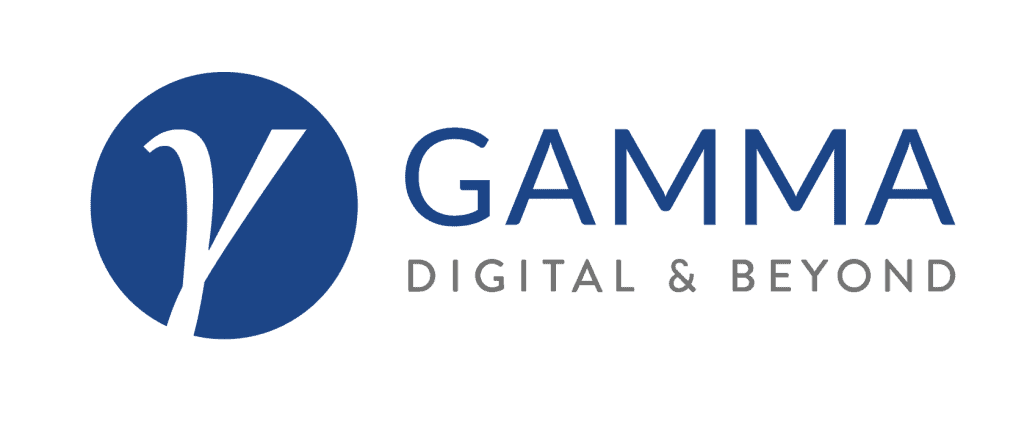
GAMMA Digital & Beyond® is an innovation and transformation consultancy. We enable small, medium-sized and large companies (a.k.a. “Mittelstand”) to accelerate, incubate and scale their innovation cycle and transformation process.
We offers advisory and consulting on both innovation and digital transformation topics. With our execution and results focused approach to innovation, we enable companies to develop working, commercially viable products/services and sustainable business models.
Enabling our clients to drive forward innovation themselves is our primary goal. This transformation is about changing the entire organization and mindset in order to remain adaptable to the ever ever-changing.
Follow GAMMA Digital & Beyond on
Photo Credits:
- Motorola
- pixabay.com
- unsplash.com
- Wikipedia


